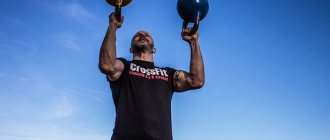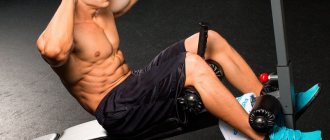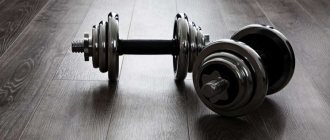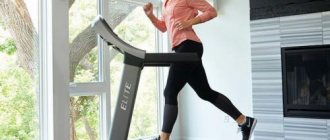Setting a goal
To create a home workout plan for the week, you need to decide on your goals. A person must understand whether he needs to increase muscle size or lose weight, then set a realistic and achievable goal. Once excessive demands are made, motivation for further studies disappears. Finding out your goal plays a huge role in developing your weekly home workout plan. Based on the data, the frequency of task completion, the number of repetitions and the structure of the training are determined. To get results, you must adhere to the established training regimen at home for 12 weeks.
What equipment will you need?
Many training plans are designed to be carried out in training centers. Physical activity involves the use of special weights and exercise equipment, which are not always available at home. To stretch the shoulder area, you will need dumbbells; they can be purchased at sports stores or replaced with plastic bottles filled with liquid. To strengthen the upper body, parallel bars or a bar are suitable.
A weekly home workout plan for flexibility involves the use of the following sports accessories:
- expander;
- fitball;
- rubber loops.
Selection of exercises
How to make a workout plan for a week at home correctly? First of all, choose the appropriate exercises. They are divided into 2 categories:
- To work out a muscle group;
- Working with your own body weight or weights.
It is advisable to focus the training complex on the muscles of the whole body.
Top part
To stretch the upper block, use weights and an expander. Trainers recommend performing the following exercises:
- on shoulders. Push-ups and dumbbell lifts, rubber band stretching;
- on the chest. Bend forward, raise your arms while lying on your stomach, gluteal bridge, warm up your back;
- on the biceps. Concentrated lifts, expander rows and weight lifting;
- for triceps. Various types of push-ups and dumbbell extensions.
Stomach
You should include abdominal exercises in your weekly home workout plan. First of all, to stretch the rectus muscle:
- twisting;
- bar;
- scissors;
- bicycle in a recumbent position;
- superman;
- climber.
Then the lateral muscles are engaged and leg lifts are performed in a side-lying position, a bridge and a side plank.
Buttocks and lower limbs
The following types of physical activity are suitable for a soft spot:
- lunges;
- deadlift;
- all kinds of squats;
- bridge.
To make it more difficult, an expander is included in the work.
The posterior femoral surface is warmed up by bending or abducting the lower limbs, squats and lunges to the side and back and forth. Walking and running on your toes will be beneficial for your calves.
Cardio loads
Your weekly home workout plan should include cardio. The following tasks are suitable:
- jumping rope;
- exercise bike;
- regular jogging.
Interval training gives a good effect. It requires extreme concentration and performance while performing intense and short exercises.
Among others, it is worth highlighting Tabata. This is high-intensity training with short rest intervals. The technique consists of 20 seconds of physical activity, then a pause of 10 seconds. Perform 8 approaches. Over the course of 1 hour, 3 to 4 types of exercises alternate.
Bodyweight exercises at home
There are many exercises for training with your own weight, below are the most effective:
Pull-ups are a basic exercise for the back muscles. You can perform pull-ups with different grips. By experimenting with grips, you can put stress on different muscle groups.
We recommend reading: How to quickly pump up m; muscles? Seven rules for building m; muscle mass
Wide grip pull-ups . The palms are located slightly wider than the shoulders. The exercise is performed smoothly, you need to try to feel the latissimus muscles, because they bear the maximum load.
Close grip pull-ups . Jump onto the horizontal bar so that your hands touch each other. By performing pull-ups in this way, the load shifts to the bottom of the latissimus muscles and biceps.
Reverse grip pull-ups . When doing pull-ups in this version, the biceps take the lion's share of the load. When performing the exercise, be collected and try to feel your biceps in each repetition.
Push-ups are a basic exercise for pumping up the pectoral muscles and triceps muscles of the arms. The number of repetitions is approximately 80% of the maximum.
Push-ups with wide arms . The exercise is performed to work the pectoral muscles. To make it more difficult, use palm rests to increase the range of motion. Try to push up as deeply as possible, stretching your pectoral muscles as much as possible.
Push-ups with elbows tucked in engage all three heads of the triceps. The exercise is performed at full amplitude and at an average pace.
Reverse push-ups . To perform this you need a bench or chair. When performing the exercise, you should not slouch and allow your elbows to diverge to the sides, otherwise the triceps will not receive the proper load.
Calculate your ideal sports weight!
Dips can be called the big brother of push-ups. Only dips are much more difficult than push-ups. The number of repetitions depends on the physical capabilities of the athlete. Athletes who have difficulty doing push-ups may not even look towards the bars.
Bodyweight squats work the muscles in your legs and buttocks. To weigh it down, use improvised means, for example, a backpack or water bottles. For those who find it easy even with weights, you can squat on one leg.
Lunges are another exercise for pumping up your legs. When performing lunges, the main thing is to keep your body perpendicular to the floor. The exercise affects all leg muscles: quadriceps, buttocks and hamstrings.
Raising your legs while hanging on a horizontal bar loads your abdominal muscles better than other exercises. The lion's share of the load is taken by the lower abs.
Forward crunches are a classic exercise for pumping up your abdominal muscles. Mostly the upper abdomen receives the load. The main thing when doing crunches is not to lift your lower back off the floor, otherwise you can get injured.
Training frequency
A home workout plan involves alternating sports activity with rest breaks. During physical activity, small cracks form in muscle cells. Their recovery takes from 24 to 48 hours and is determined by the intensity of exercise. Experienced athletes recommend doing strength training 3-4 times a day. in Week. It is advisable to select exercises to include different muscle groups.
Cardio training increases your heart rate, so you should not overdo it. The optimal cardio rate is from 3 to 4 r. in Week. The best option is to alternate strength tasks with cardio training. It is advisable for beginning athletes not to bother themselves and take more days off.
Training program for girls using plyometrics
This type of training is suitable for girls who are already familiar with intensive training and who have no contraindications to this type of training (see above).
Type of training: classic training in sets (x4 - 4 sets or x1 - 1 set). Rest between sets – 7 seconds.
Working muscle groups: chest, arms and legs.
Working time: 30 seconds (this is one approach).
Rest: 7 sec.
Equipment: dumbbells 1-3 kg, jump rope.
Warm-up and joint gymnastics - 5-7 min
- Stepping up a hill – 30 seconds with each leg in turn (x4)
- Burpees with push-ups – 30 sec x1
- Scissor plank – 30 sec x1
- Raising arms to the sides while lying on your back – 30 sec x4
- Squat jump – 30 sec x1
- Jumping rope – 30 sec x1
- Squat and leg lift to the side - 30 seconds with each leg in turn (x4)
- Wide grip push-ups upside down – 30 sec x4
- Squat jump with a 180 degree turn – 30 sec x1
- Jumping lunges – 30 sec x1
Stretching
The right start
To obtain the desired results and to prevent injury, a warm-up must be included in your home workout plan. She helps:
- restore joints and muscles;
- reduce tension and pain in muscles;
- minimize injuries;
- improve athletic fitness;
- increase the flexibility of the body and mobility of all its members.
If desired, they can play sports using online broadcasts. Such trainings are conducted by experienced professionals. The proposed instructions will help novice athletes master the correct technique for performing sports tasks.
When the scheme is changed
The workout schedule at home has to be changed periodically. This is required so that all muscle groups are included in the work, and a noticeable result appears. Trainers are advised to maintain the basic structure of the training process, but periodically change the number of repetitions and exercise variations. The optimal period for changing the training plan is 3 months.
Beginners can extend this time. Because it is important for them to learn the correct technique for doing the exercises. The training scheme is changed in the following cases:
- to increase the intensity of classes;
- when adding new tasks;
- increase the number of repetitions if desired.
The main challenge in doing home workouts is to tailor your physical activity plan to your fitness goals. And if you combine proper nutrition with sports activities, you can get stunning results in a month.
Step-by-step recommendations for creating a workout program at home
- The first thing you must do is determine in what order and what you will do during your training, that is, determine the sequence of the training process.
- And the second step is to choose (if necessary write down) the exercises that you will do during your workout.
Sequence of the training process
When we talk about any workout, we must remember the main parts of which it consists, but depending on what type of training we choose, the number of these parts will depend. For example, let's take classic strength training. Its sequence should be like this:
- Warm-up and joint gymnastics - 5-7 min
- Main part – 45-60 min
- Cardio* – 10-30 min
- Stretching – 5 min
*This stage is desirable, but if it is not possible to do cardio after strength training, then you can do it on a separate day.
If you decide to do plyometric or interval training, then the sequence remains the same, but with some changes in the duration of the main part and cardio.
- Warm-up and joint gymnastics - 5-7 min
- Main part – 15-40 minutes
- Cardio* – 10-20 min
- Stretching – 5 min
*There may not be a cardio component after the main part, or you can leave it. It all depends on the duration of your workout and its intensity. The longer and more intense your main part is (35-40 minutes), the more likely it is that you simply won’t need to do cardio after it, since you will already be training very intensely. But if your workout only took 15 minutes and the intensity was moderate (not at your maximum), then it probably makes sense for you to do another 20 minutes of light cardio at the end. There is no single template here; you should always focus on your feelings and take into account the goal that you want to achieve with these workouts.
Principles of home training
When you independently create a training program at home , you need to approach this issue responsibly and think carefully about the structure of the training, as well as the number of approaches and repetitions of each exercise. Doing exercises “from scratch” you will not be able to achieve the desired goals and achieve good results, no matter how much you train.
Basic rules when creating a training program:
- Determining the working muscle groups that you will work during your workout (for example, back and chest or buttocks, legs and abs);
- Choice of exercises;
- Determining the rep range or time to complete the exercise (for example, 20 reps or another option: 40 seconds of work and 15 seconds of rest);
- Thinking in advance about modifications (variations and complications) of your exercises during training:
-principle of “shortened amplitude” (pumping)
-use of statics
-change in working weight
-increasing intensity, etc.
Using these simple rules, you can very competently structure your training process and get the most effective results from it.
Now, let's move on to looking at several training programs for girls at home using different techniques and principles.
Drawing up an individual training program











